When out foraging for edible and medicinal plants, it is just as important—if not more so—to know how to identify the poisonous plants that grow in your region. Poison hemlock (Conium maculatum) is one of those that everyone should know how to identify, as it can be quite prolific in some areas.
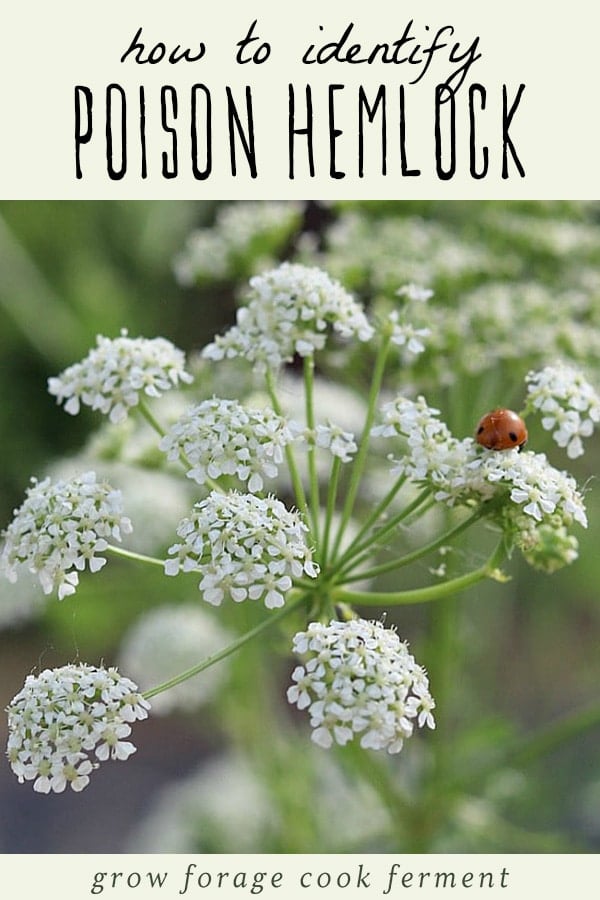
Want to save this post for later?
Wildcrafting Weeds
If you want to learn more about the edible and medicinal weeds that surround us and how to use them, check out my eBook: Wildcrafting Weeds: 20 Easy to Forage Edible and Medicinal Plants (that might be growing in your backyard)!

About Poison Hemlock
Poison hemlock (Conium maculatum) is in the Apiaceae family, which also includes carrots, parsnips, parsley, fennel, and their wild counterparts.
It is an herbaceous biennial plant that can grow 5 to 10 feet (2-3 meters) tall or even taller.
It should not be confused with hemlock the coniferous tree which is completely harmless (and edible).
All parts of the plant are poisonous, including the flowers, leaves, stems, roots, and seeds.
Poison hemlock contains potent toxic alkaloids that affect the nervous system, and even small internal doses can cause respiratory collapse and death.
It can also cause a severe skin reaction similar to a burn when touched externally. Definitely not a plant to mess around with!
Historically poison hemlock was used in ancient Greece to poison condemned prisoners, and it was what killed Socrates after he drank a potent hemlock infusion.
First: Get a Foraging Guidebook
To the untrained eye poison hemlock can sometimes be confused for some popular foraging plants such as Queen Anne’s lace, yarrow, wild fennel, and elderflower.
Before doing any foraging or wildcrafting, especially for plants that may resemble poison hemlock, it’s extremely important to get a foraging guidebook. Here are a few of my favorites:
- The Forager’s Harvest by Samuel Thayer
- Nature’s Garden by Samuel Thayer
- Identifying and Harvesting Edible and Medicinal Plants by Steve Brill
Related: 12 Best Books on Foraging and Wildcrafting
Where Does Poison Hemlock Grow?
Poison hemlock (Conium maculatum) is native to Europe and North Africa, but has widely naturalized in many other areas. It is found in almost every state in the United States, and in most Canadian provinces.
This USDA map shows generally where it is found in North America, and here is a more detailed map that shows which US counties it is found in.
I didn’t find any distribution maps for other countries, but poison hemlock does also grow in Europe, North Africa, Asia, Australia, and New Zealand.
Poison hemlock naturalizes very easily and can be found growing in disturbed areas, along roadsides and trails, and in damp areas along streams.
In our region I find it alongside bike paths, near park edges and fields, and in dense colonies near the freeway.
If you happen to find poison hemlock in or near your yard it is advised to properly remove it as soon as possible, especially if there are children around.
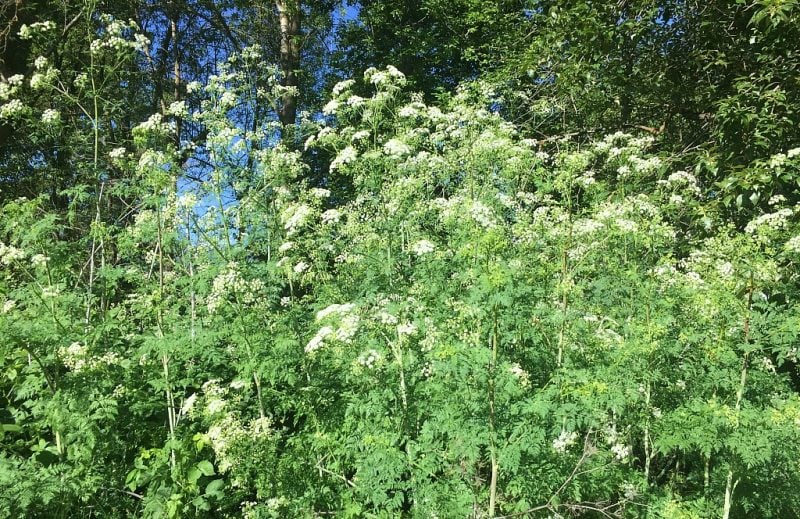
How to Identify Poison Hemlock
Poison hemlock really isn’t hard to identify, and there are a few key identification features to be on the lookout for.
Stems
The most important identification feature of poison hemlock are the stems and stalks.
Poison hemlock stems are hairless, hollow, and almost always have distinctive purplish-red splotching or streaking on them, especially towards the base of the plant.
These purple or reddish colored markings are a sure giveaway that it is poison hemlock.
Many sources say that the stems of poison hemlock don’t always have this splotching, though I have never found poison hemlock without it.
Regardless, it’s always a good idea to know more than one identification feature, especially when dealing with poisonous plants.
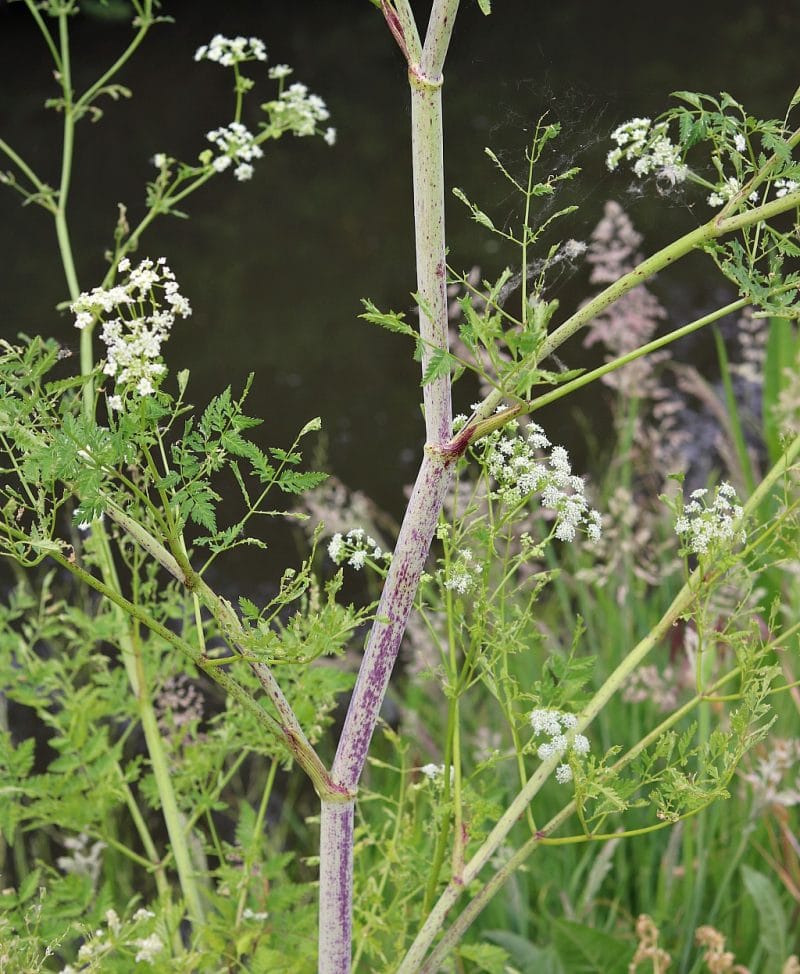
Flowers
Poison hemlock flowers can be confusing because they resemble other white umbel shaped flowers, especially those in the Apiaceae family.
The flowers bloom in late spring and grow in rounded clusters that are called compound umbels. Each individual tiny flower has five petals.
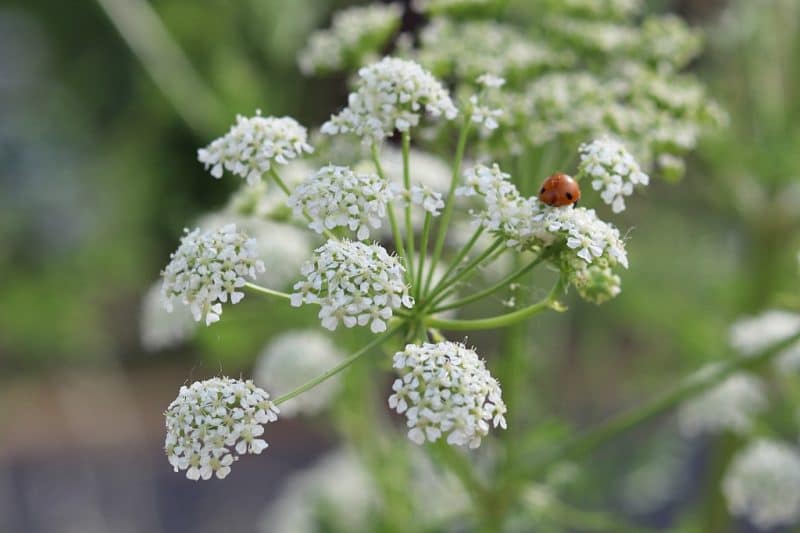
After the flowers bloom they form small green fruits with wavy ribs that contain highly poisonous seeds that resemble anise, fennel, or caraway seeds.
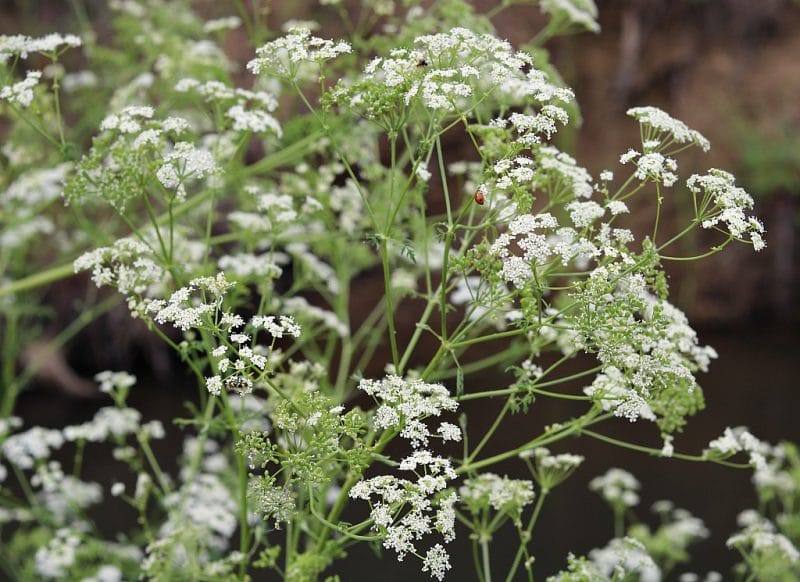
Poison hemlock flowers grow on highly branched stalks that can grow up to 8-10 feet (3 meters) tall.
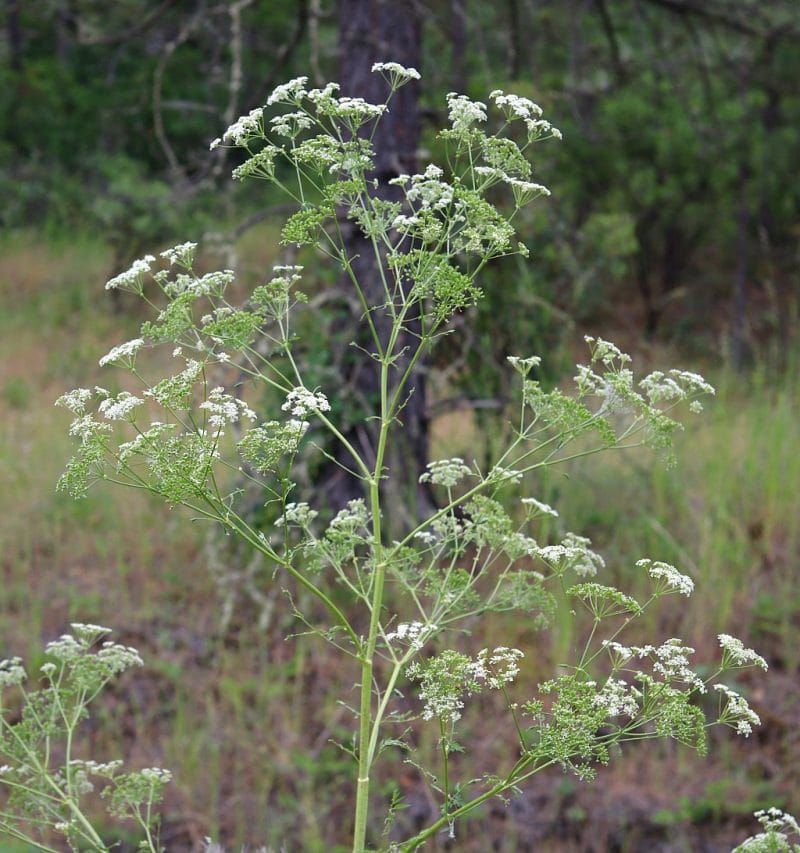
Leaves
The leaves of poison hemlock look very similar to parsley, chervil, and wild carrot (Queen Anne’s lace), which makes them difficult to distinguish.
They are opposite and compound, hairless, lacy, and triangular in shape.
When crushed or brushed against, the leaves emit a very unpleasant musty smell, not at all carrot-like like Queen Anne’s lace.
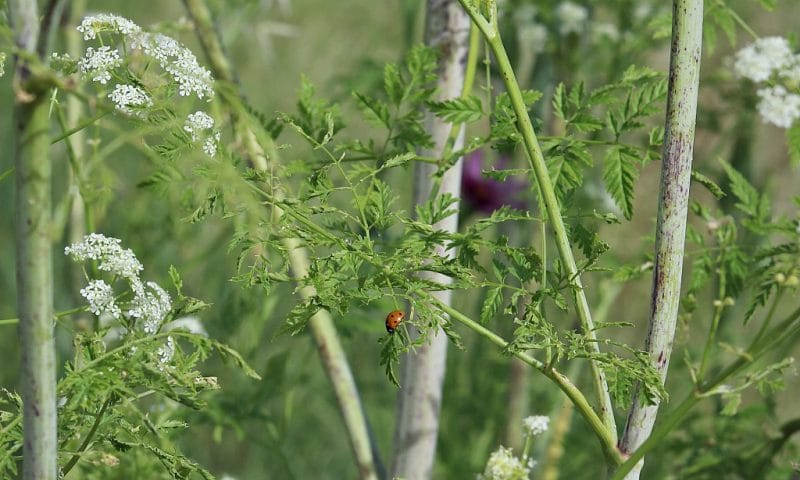
Potential Poison Hemlock Look-Alikes
The reason it’s so important to learn how to identify poison hemlock (Conium maculatum) is because it is often mistaken for other plants that are edible and medicinal, most notably Queen Anne’s lace.
Here I will explain the major differences between the edible and medicinal plants that poison hemlock can potentially look similar to.
Queen Anne’s lace (Daucus carota)
There are several differences here to consider.
First is overall size, as Queen Anne’s lace only grows to about 2-3 feet in size.
Queen Anne’s lace has hairy stems and leaves, while poison hemlock’s are smooth. Here is one easy way to remember it: “the Queen has hairy legs.”
Queen Anne’s lace flowers bloom later in the summer and have a flatter shape. They typically have a single dark purple or red flower in the center.
Queen Anne’s lace also has 3 pronged bracts at the base of the flowers, and the older flowers curl up into a bird’s nest shape.
Queen Anne’s lace is edible and can be used in various ways, including Queen Anne’s lace fritters.
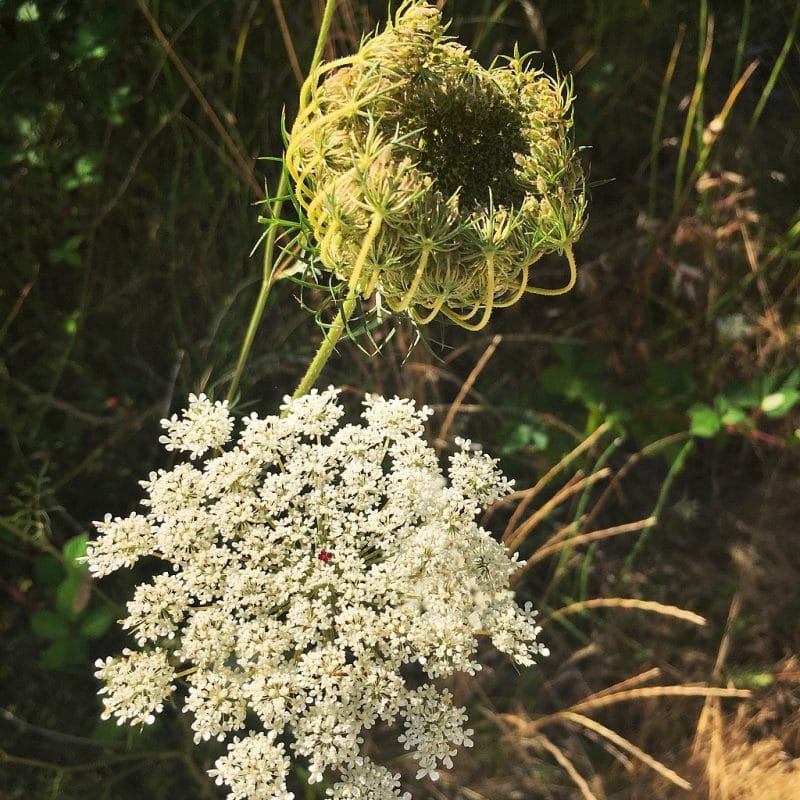
Yarrow (Achillea millefolium)
The biggest difference that yarrow has from poison hemlock is its distinctive frilly, feather-like leaves. You can see pictures of the leaves in my post about foraging yarrow.
The flowers also look a bit different, as yarrow is not in the Apiaceae family so does not have a true umbel flower.
Yarrow is also a smaller plant, growing to about 2-3 feet in size.
Angelica (Angelica spp.)
Angelica has similar looking flowers to poison hemlock, although even more rounded and sometimes light green in color.
The leaves of angelica are much larger and are compound with dozens of leaflets. There is also a sheathing base where the leaf meets the stem.
Perhaps the most noticeable feature of angelica is its pleasantly fragrant scent.
Angelica can also look very similar to water hemlock (Cicuta spp.), which is another highly poisonous species that can cause death.
Cow Parsnip (Heracleum maximum)
The flowers of cow parsnip are similar to poison hemlock, but much larger, and same goes for the leaves.
It can also closely resemble water hemlock, so be absolutely certain of your identification.
Cow Parsley/Wild Chervil (Anthriscus sylvestris)
Cow parsley has pink stems that are slightly hairy and have a groove.
Be aware that it can also closely resemble fool’s parsley, another poisonous plant.
Wild Parsnip (Pastinaca sativa)
Wild parsnip has yellow flowers and the stem is grooved.
Be aware that while this plant has edible roots, the leaves and stems can cause burns and blisters on the skin after touching.
Water Parsnip (Sium suave and Berula spp.)
Water parsnip grows in marshes and wet areas, and the leaves are not lacy like poison hemlock.
I highly recommend using the book Incredible Wild Edibles by Samual Thayer for identifying this species.
Water parsnip looks very similar to water hemlock, another deadly plant, so great care should be taken to obtain positive identification before harvesting.
Wild Fennel (Foeniculum vulgare)
Wild fennel has a similar overall structure to poison hemlock.
The main differences is that wild fennel has yellow flowers, frond like leaves, and smells strongly of fennel or anise (a licorice-like scent).
Elderflower (Sambucus spp.)
There is only one minor similarity that elderflowers might have to poison hemlock, and that is the white flowers.
Elderflowers do not have the true umbel shape and are usually much larger. They turn into elderberries as the summer progresses into fall.
The elder plant itself is more of a large tree-like shrub and doesn’t really bear any resemblance to poison hemlock.
Three Other Similar Looking Poisonous Plants
It’s also worth mentioning that there are three other poisonous plants that are also in the Apiaceae family that look somewhat similar to poison hemlock and the other plants I listed above.
- Water Hemlock (Cicuta spp.) – water hemlock is more deadly than poison hemlock and is almost as widespread. There are four different varieties, with spotted water hemlock (Cicuta maculata) being the most common.
- Giant Hogweed (Heracleum mantegazzianum) – giant hogweed is literally giant, growing up to 18 feet (6 meters) in height with leaves that are 3-5 feet (1-2 meters) wide and flowers that can be 2.5 feet (almost 1 meter) in diameter. It causes horrible skin blistering, permanent scars, and blindness.
- Fool’s Parsley (Aethusa cynapium) – fool’s parsley is less poisonous than poison hemlock, but is still one that you most definitely want to avoid. It has hairless stems and long bracts that hang below the secondary flower clusters.
Apiaceae can be a tricky family to identify, especially when there are several poisonous species to worry about. Poison hemlock really isn’t hard to identify once you know what to look for.
This guide is here help you learn all of the features of poison hemlock and its look-alikes so that you can feel more confident in your foraging adventures!
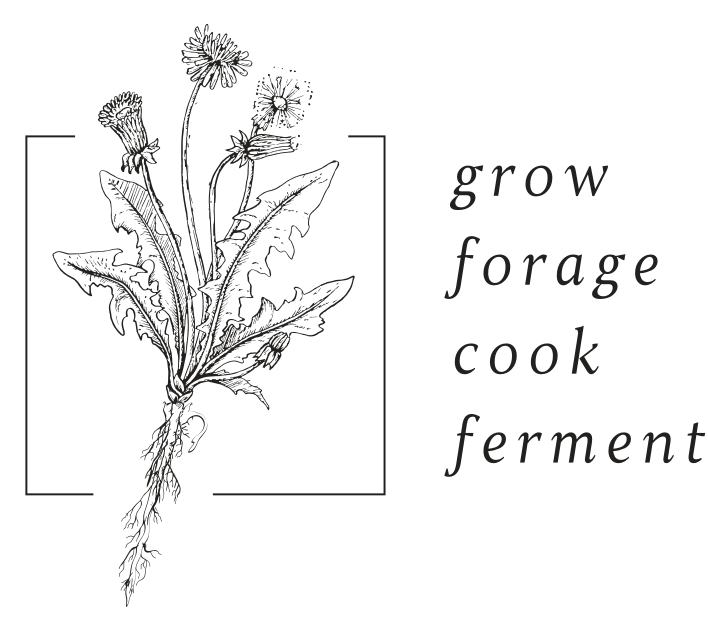
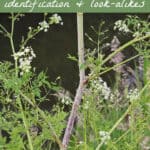
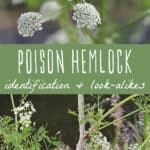
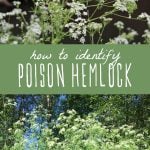

This guide is excellent! Residing in a region abundant with these plants, I’ve struggled to identify them correctly, especially angelica. It’s been challenging to confidently differentiate it from similar species. The in-depth information on their unique traits is extremely beneficial. Thanks a lot!
This guide is fantastic! Living in an area rich with many of these plants, I’ve faced challenges in accurately identifying them. This is particularly true for angelica, as confidently distinguishing it from its similar-looking counterparts has proven difficult. The detailed insights into the distinctive characteristics of these plants are incredibly helpful. Thank you!
This guide is wonderful! I reside in a region abundant with many of these plants, and accurately identifying them has been challenging. This is especially true as I have a keen interest in angelica, but confidently distinguishing it is hard due to its similar-looking counterparts. Detailed insights into the distinctive characteristics of these plants are immensely useful. Thank you!
This guide is fantastic! I live in an area where many of these plants are found, and confidently identifying them has been a difficult endeavor. This is particularly the case since I’m fond of angelica, but distinguishing it with certainty is tricky because of its look-alike species. Any detailed information about the unique traits of these plants is very helpful. Thanks!
This is an excellent guide! I reside in a region where many of these plants coexist, and cataloging them confidently has been a challenging task. This is especially true as I’m a big fan of angelica, but identifying it with certainty is tough due to its many similar-looking counterparts. Every bit of information about the distinct characteristics of these plants is beneficial. Thank you!
I totally agree that when out foraging for edible and medicinal plants, it is just as important—if not more so—to know how to identify the poisonous plants that grow in your region. This is very helpful.
Just a word of warning. I came across so many poison hemlock in Epping Forest but although the stems were hairless, the leaves triangular + the flowers had neither a dark dot centre nor a bracket to hold them like QAL, I thought ‘this’ simply CANNOT be poison hemlock: their stems have zero purple splotches! No splotching at all. I pulled out a long sprig home to investigate online. Yes, it fits the bill but no purple. Thinking something must be missing in my understanding, I returned to the forest another day to look at them. To my horror, I realised I did miss something. When I look way down at the lowest base, all these tall but young poisonous plants had purplish-red base – invariably. Unmistakably. So please, do, look all the way down, not just meticulously + naturally at eye to hip level, only.
Glad to see I’m not the only one who got fooled by this species. Today I inspected a suspicious-looking clump of flowering plants in a nearby urban park. Everything indicated that they were poison hemlock,,,but I couldn’t see any of the notorious purple spots on the upper stems. Being no longer a young man, I had neglected to stoop down and check the lowest point where the stem emerges from the ground. It’s good to rely on authoritative guidebooks and technical keys. But it’s also a good idea to be meticulous and very thorough when dealing with an unknown plant that might possibly be toxic. Careless or hasty decisions based on perfectly valid information can lead to unfortunate results. Luckily for me, I had been wary enough not to touch any part of the hemlock plants that had initially confused me. In the future I’ll give them a wide berth.
The definitive between poisonous and not is that the tuber of the poisonous has hollow cavities within the tuber. Yampeh, poison hemlock, water hemlock. Would you agree or maybe not?
You want to put on protection before handling including gloves and a mask. Ìt sent an elderly man to the icu shortly after pulling them like weeds on his property an hour later, and my mother developed huge festering welts that itched incessantly. I would recommend pulling these so the seeds don’t get caught in the wind and replant themselves. The diy vinegar+salt solution is more of a cracks and crevice, stone driveway weed spray and is best used during the heat of the day. But I found my portable steamer worked even better, both day or night, and killed the roots instantly as apposed to waiting for dehydration to slowly wilt away. Poison Hemlock you don’t want to just spray and wait for the wilting process during the hot sunny day w/o the chance of precipitation to foil your efforts. The steamer will kill the root and stem structure of plants instantaneously, but still need to remove and dispose of, with gloves and mask, to avoid the dangers of the poisonous flowers that causes nasty long lasting skin irritation, (think poison ivy on steroids) spreading and itching into infection, and worse, infiltrate the lungs, aggressively becoming harder and harder to breathe before you’re able to signal for help. You don’t want you’re pets, family, or children accidentally strolling through and picking the beautiful flowers to show mommy how much they love you.♡
Hi Catherine, thank you for sharing your experience. When do you apply the steamer, directly to the roots after digging up, or when the plant is still in the ground?
Thanks for this really important guide! Will definitely keep this in mind when seeing any plants with white flowers and umbels. Very helpful!
Could I add how similar this looks to Canby’s Licorice root (Ligusticum canbyi). Just as a word of caution. I was surprised by the resemblance. Thanks for your work and research!
Thank you for sharing knowledge of this serious and this natural deadly poison hazard that is these hemlock- in fact many are truly unaware as our negligent government and local leaders do not protect our populations from much, and neglect themselves most often from their duties to us and our children.
I now can thoroughly inform myself and children about this terrible danger.
Thank you
Again
Marina Price
Thanks for the info. There is a hiking trail near me with Hemlock all over the place!
Thank you for the info. To get rid of poisonous plant are you aware of a weed killer using vinegar epsom salt and dawn dish soap!
The exact mixture I am not sure but starts as 1 gallon of vinegar. A cup of Eason salt, and a cup of dawn soap.
The vinegar is and acid to burn the plant the salt dries it and the soap penetrates the plant oil so as to make the other ingredients work. This will go down into the roots to kill all of it. Spraying on dry days make it work much better and you must leave it alone even if it looks dead as it will wipeout the root system.
I hadn’t heard that! Thanks for sharing!
I have hundreds of little sprouts of what looks like Queen Anne’s Lace. We just moved to this property in Mid Missouri last year after it had been neglected for a few years. I have been pulling these out bare handed. There are no spots or markings on the stems, and they are velvety in texture; not hairy. But the flowers look suspiciously like hemlock. The sprouts that are not more than 3 inches tall are flowering, I think, due to being mowed in with the lawn. They do have a big tap root like a carrot. I have not noticed an unpleasant odor from pulling them and have had dozens in my bare hands at once. I have not had any dermatitis. I’d really like to find out what kind of weed this is and confirm that it is not hemlock. Side by side pictures of young plants would be helpful.
It doesn’t sound like poison hemlock. There are a lot of plants that have similar looking umbels, so it’s hard to say without seeing them myself.
Do Queen Anne’s Lace and poisonous Hemlock grow together? Like in the same ditch?
They definitely can. I typically see poison hemlock growing near cow parsnip, which is another look alike.
Thank you for your comprehensive list. There are a lot of apiaceae type plants growing in Central Vermont. I’m trying to document the characteristics of all the local white umbel plants. Your article helped me tremendously.
There are two hmong herbs for chicken soup and used during the 30 days postpartum diet for hmong women. one looks like poison hemlock and the other like water hemlock. both are perenials and only get bigger each year. They only grow to be 2 feet tall. Can I email you pictures to identify?
Thank you.
Hello Mai,
I am interested in your hmong herbs.
Do your plants experience cold winters?
Some hemlock are edging our pond in Maine.
Would like to compare. Thank you.
Alda
That map in the link is inaccurate. Poison and water hemlock grows in Florida.
Thank you so much for your help of knowing the difference between elderflower and poison hemlock
I bought my yarrow at the greenhouse, but it is tall5-6 foot
Hi,
I enjoyed your info.. it helped me know the difference from the water hemlock, poison hemlock and my new find on my land!!! Elderberry!! Look forward to taking your mini course😁
Hi Colleen! I mistakenly ate poison hemlock back in 2010; I thought it was a volunteer carrot in my shared garden. I’m working on preparing for a talk I’m giving about building resilience in non-profits and I’ll be leading with my story. (I fermented it thankfully, which a chemistry professor friend said likely lowered its toxicity).. I was looking online for photos and came across your site. Peace upon you and yours and your good work. – David Westerlund, Bellingham
Thanks for the article. Good info!
However, the Cow Parsnip leaf I find, is not like posion hemlock leaves at all. Cow parsnip leaves do not have that ‘ feathery, wild carrot like look’ like the Poison Hemlock does. The leaves of the cow parsnip are much larger as well, even when young.
I stumbled onto this page looking for what weed is growing in my yard. It looks like hemlock but isn’t. The leaf is all wrong. I finally found it in pictures. I wanted to update your page with…It could also be Large Leaf Water Parsnip. Mine isn’t growing in water. It’s in the shade. It smells wonderfull. A lot like milkweed flowers. When cut it is hollow inside like hemlock. It says it’s not poisonous though!
Excellent! Thank you!!
Thank you for taking the time to assemble this excellent and comprehensive guide. You should certainly spare a forager or two from Socrates fate. I will be certain to share as the need arises.
This is a wonderful and helpful article. I worked in the field for many years as an aquatic plant specialist. During that time I learned that many gardeners use compost from sources such as mushroom growers. While this compost is effective, it is not always free of wild seeds. I have seen gardens with wild carrot-type plants growing next to cultivated carrots and have heard of people pulling the wrong ones for the dinner table. A dangerous mistake for sure.
Wonderful comment. We often use mushroom compost and compost from the city.
What a great guide! I live in an area where most of these plants grow together and it’s been hard work confidently cataloging them. Particularly because I absolutely adore angelica, but feel uncomfortable being definitive with it with all these confusing lookalikes around. Every little bit of info about these plants differences helps. Thanks!
Angelica is actually one of the easiest, the crushed or cut stems and leaves have a distinct anise spicy sweet smell and it’s easy to see why it was used in candy. None of the toxic ones come close at all